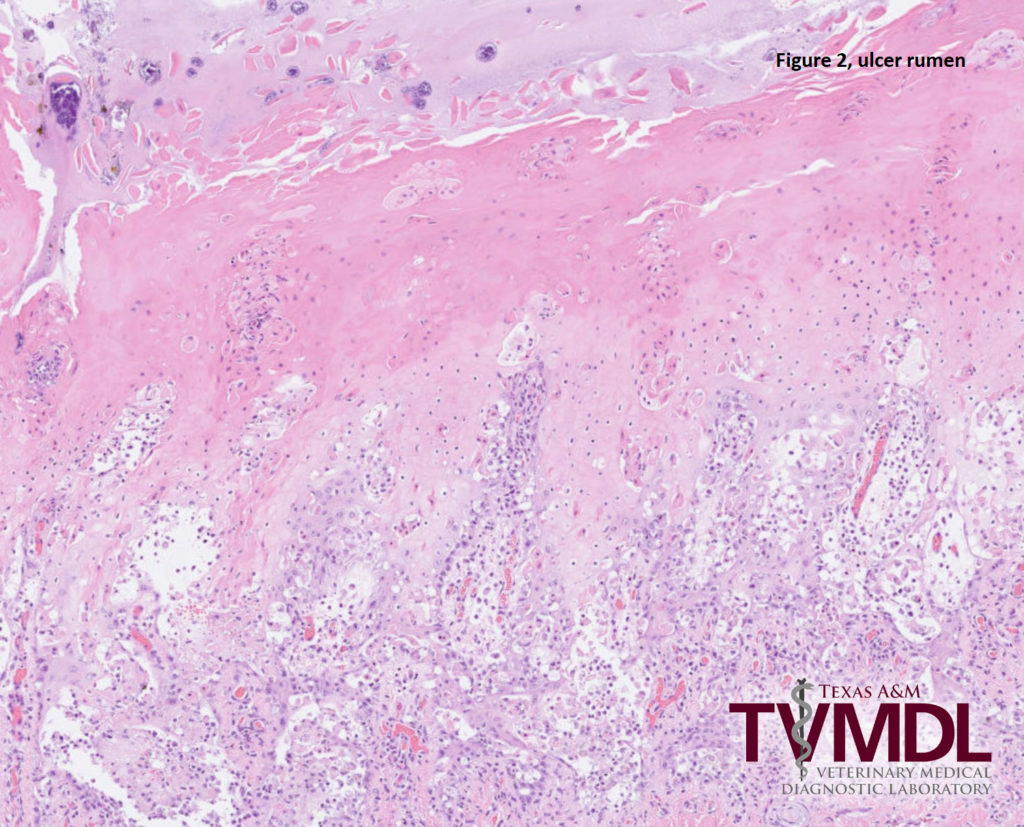Malignant Catarrhal Fever in a 1-Year-Old Heifer
R. Gayman Helman, DVM, PhD, MA, Guy Sheppard, DVM, and Megan Schroeder, PhD
A 1-year-old heifer became weak and went off by herself in mid-April. The heifer was examined by the submitting veterinarian a few days later and was described as being lethargic, having a drooped head, oculonasal discharge, conjunctivitis/scleritis, mild mucosal petechiations, and frank blood in the urine. The heifer was weak and ataxic and would fall down and get back up frequently. The heifer’s temperature at presentation was 103°F. Treatment with florfenicol and oxytetracycline, vitamin B-12, dexamethasone, and IV fluids was administered. Treatment with oral and IV fluids was repeated a day later, at which time bilateral corneal edema and hypopyon were noticed. The heifer continued to be ataxic and died two days after treatment began.
A variety of fresh and fixed tissues were submitted to the Texas A&M Veterinary Medical Diagsnostic Laboratory (TVMDL) in Amarillo for diagnostic testing. Histopathology was pursued initially. Lesions were noted in a number of organs including brain, liver, kidney, spleen tongue, forestomachs, intestines, and urinary bladder. There were early perivascular accumulations of lymphoid cells in the brain. The liver and kidney both had multifocal lymphoid infiltrates and vasculitis was identified in the spleen and kidney (Figure 1). There were erosions and ulcerations affecting mucosal surfaces on the tongue and forestomachs (Figure 2) and extensive ulceration of the bladder mucosa.
Additional testing utilizing PCR technology for Malignant Catarrhal Fever (MCF) and Blue Tongue (BT) viruses followed. The BT virus was not detected, but MCF was positive with a CT value of 28.40.
MCF is caused by viruses of the Macavirus genus that are in the Herpesviridae family (Gammaherpesvirinae subfamily). Two major groups of MCF viruses include one that primarily affects exotic even-toed ungulates and one in sheep, goats, and white-tailed deer. The viruses are named after the reservoir host which serve as carriers. Of these, the most common types in the United States are the sheep-associated virus and the wildebeest-associated virus. The sheep virus is the most common source of the virus in the United States, but with the increased appearance of exotic ungulates, the wildebeest associated virus has also been identified as a cause of disease in cattle.
Clinical signs in this heifer are fairly typical for MCF, and the disease is normally fatal in cattle which are a dead-end host for both the sheep and wildebeest-associated viruses. The lymphoid infiltrates and proliferation may be so severe that nodes may look like lymphoma. MCF is easily transmitted horizontally between reservoir and non-reservoir, susceptible hosts however, there is no apparent horizontal transmission between sick bovine and other healthy cattle.
Separation of cattle and sheep or cattle and reservoir exotic ungulates is advisable and the best mode of prevention. There are no commercially available vaccines.
In this case, the cattle on this ranching operation were on the same pasture with sheep. The ewes had just started lambing, but there were several heavy lambs born several months prior. The scientific literature indicates weaning-age lambs are the primary risk in MCF viral shedding.
Differentials for MCF include Bovine Viral Diarrhea (BVD), BT, and Rinderpest, a foreign animal disease. In cattle dying of MCF, a broad sampling of tissues exhibiting gross lesions to include both fresh and fixed samples will provide the best opportunities for definitive identification. This would include ulcerative lesions, enlarged lymph nodes, and organs such as liver, kidney, lung, heart, spleen, and brain.
For more information on this case, contact Amarillo Resident Director Dr. Gayman Helman, Veterinary Diagnostician Dr. Guy Sheppard or Dr. Megan Schroeder in College Station. To learn more about TVMDL’s test offerings, visit tvmdl.tamu.edu or call one of our full-service laboratories.
References:
- Center for Food Safety and Public Health, Iowa State University College of Veterinary Medicine, Malignant Catarrhal Fever (http://www.cfsph.iastate.edu/Factsheets/pdfs/malignant_catarrhal_fever.pdf)
- The Merck Veterinary Manual (http://www.merckvetmanual.com/)

